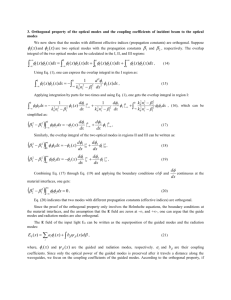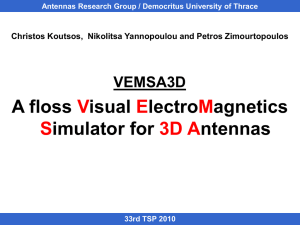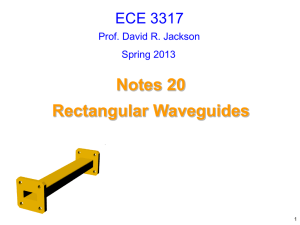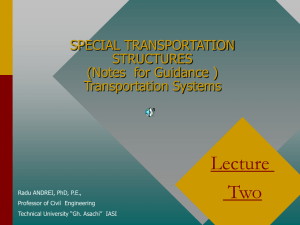Mode Orthogonality in Waveguides - ECE 6340 Lecture Notes
advertisement
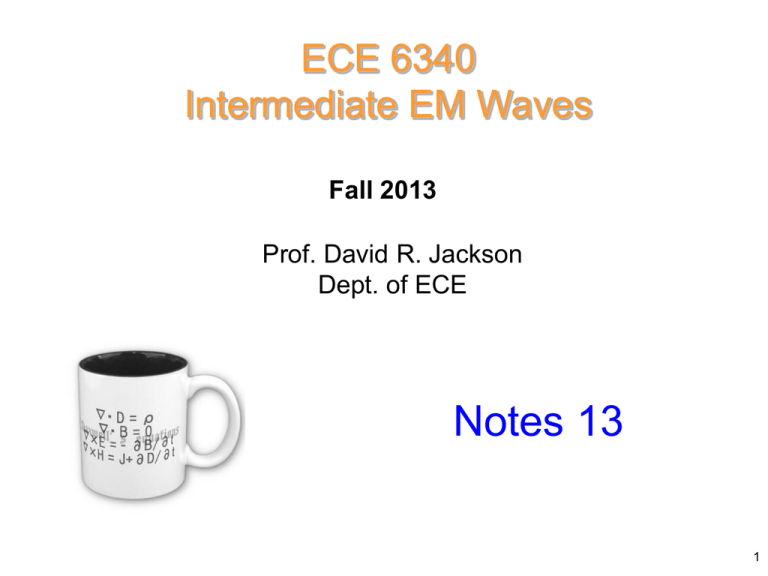
ECE 6340 Intermediate EM Waves Fall 2013 Prof. David R. Jackson Dept. of ECE Notes 13 1 Mode Orthogonality z Mode “m” (Em, Hm) Mode “n” (En, Hn) ec C Waveguide modes are “orthogonal” (in the complex power sense) if: (E * m H n ) zˆ dS 0 S 2 Mode Orthogonality (cont.) Assume two modes are orthogonal, and examine the complex power flowing down the guide when two modes are present: Pz 1 2 (E H * ) zˆ dS S 1 2 ( E m E n ) ( H * m S 1 (E 2 * m H m ) zˆ dS S 1 2 * H n ) zˆ dS (E 2 * n H n ) zˆ dS S ( E m H n ) zˆ dS * S 1 1 2 ( E n H m ) zˆ dS * S 3 Mode Orthogonality (cont.) Hence Pz Pz (m ) Pz (n) If two modes are orthogonal, the total complex power is the sum of the two complex powers of the individual modes. 4 Waveguides with PEC Walls (There may be a lossy material inside the waveguide.) Theorem 1 A TEz mode is always orthogonal to a TMz mode. Theorem 2 Two TMz modes (or two TEz modes) are orthogonal to each other if they are not degenerate: k zm k zn 5 Degenerate Modes Degenerate modes are not in general orthogonal. A simple example is two modes that are really the same mode. TE10 mode + 1 Watt = 1 Watt 4 Watt If the mode doubles, the fields are twice as strong, and hence the power increases by a factor of four. 6 Degenerate Mode (cont.) Sometimes the modes are orthogonal, even when they are degenerate. Square waveguide: TE10 and TE01 modes These two modes are already orthogonal (even though they are degenerate). 7 Degenerate Mode (cont.) If two modes of the same type are degenerate, but they are linearly independent, we can always choose a combination of them that will correspond to two orthogonal modes. Circular waveguide: Two TE11 modes Not orthogonal Orthogonal 8 Rectangular Waveguide For a rectangular waveguide, two modes of the same type (TEz or TMz) will be orthogonal provided that the mode indices are not exactly the same. m 1 , n1 m 2 , n 2 The proof is left as a homework problem. (Use orthogonality of the sin and cosine functions that make up the field variations in the x and y directions.) 9 Appendix Here we mention some other types of orthogonality relations that exist for waveguides: Orthogonality for waveguides with lossy walls Orthogonality for the longitudinal fields Orthogonality for the transverse electric or magnetic fields 10 Waveguides with Lossy Walls The previous two theorems hold for a waveguide with lossy walls if we change the definition of orthogonality to be: ( E m H n ) zˆ dS 0 (The lossy walls are modeled as an impedance surface.) S (Note that there is no conjugate here.) However, in this case, we can no longer say that the total power flowing down the waveguide is the sum of the individual mode powers. 11 Orthogonality for Longitudinal Fields Consider two non-degenerate modes that are either both TMz or both TEz. Then we have that TMz (E (m ) z E (n) z ) dS 0 k zm k zn S TEz (H (m) z H (n) z ) dS 0 k zm k zn S Assumption: lossless walls Note: If the two modes are degenerate, but they are linearly independent, we can always choose a combination of them that will correspond to two orthogonal modes. 12 Orthogonality for Transverse Fields Consider two non-degenerate modes that are either both TEz or both TMz. Then we have that for either case, (E (m ) t (n) E t ) dS 0 k zm k zn S (H t (m ) (n) H t ) dS 0 k zm k zn S Assumption: lossless walls Note: If the two modes are degenerate, but they are linearly independent, we can always choose a combination of them that will correspond to two orthogonal modes. 13 Orthogonality for Transverse Fields (cont.) Consider one mode that is TEz and one mode that is TMz. Then we have that (E TM t TE E t ) dS 0 S (H TM t TE H t ) dS 0 S Assumption: lossless walls This orthogonality is true whether the modes are degenerate or not. 14 Reference To see a derivation of the orthogonality theorems presented here, and others, please see the following reference: R. E. Collin, Field Theory of Guided Waves, IEEE Press, 1991. 15

